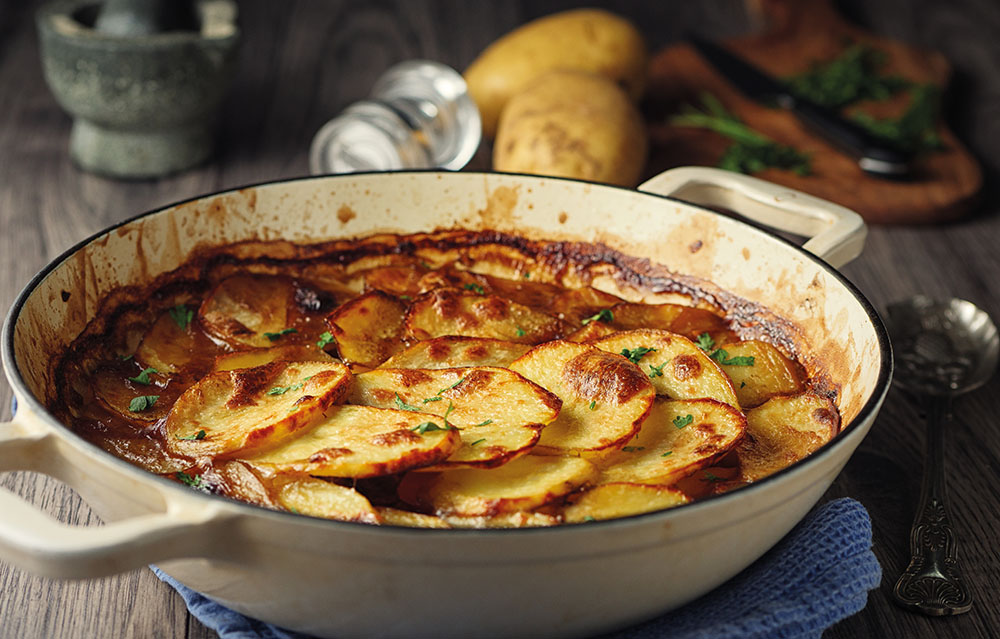Alex Rushmer uses powers of reduction to create rich and comforting winter dishes to warm the soul
Let’s face it: February is nobody’s favourite month. The sprightly mornings of spring are still several weeks away – especially if last year was anything to go by – and the menu is still dominated by dark, heavy, robust flavours and ingredients like brassicas, roots and game. Of course, there is nothing wrong with kale, beetroot and partridge, as well as their various cousins, but it does leave one craving the arrival of asparagus, wild garlic and the tender green leaves that signify the start of several months of produce that has felt the warmth of the sun, as opposed to the chilling embrace of the cold earth.
Despite that, there is still some solace to be had in the kitchen. My love of braised food has been well documented on these pages. The alchemy that takes place inside a closed pot when tough pieces of meat and gnarly vegetables yield to the warmth of an oven over several hours is still something that brings me joy. When collagen-heavy cuts form a friendship with wine (or even water) and herb or spices, it is a joyously unbreakable bond, the only improvement coming from the introduction of hearty carbohydrates. This happy triumvirate is one that appears throughout the European cookery canon and must have served our ancestors well prior to the advent of double glazing and phone-operated thermostats. Historically, this style of cooking is dominant in countries and cultures where bread was the staple filling agent: the heat from communal bread ovens once the bread had been baked would have provided an alternate heat source other than the hearth or open fire in the home.
The ingredients would have been assembled together in a pot at home then sent to the baker’s oven to cook slowly throughout the day. It is lazy food that doesn’t need attention or stirring or nurturing. Food that could sit all day in the fading heat of a large space until being collected on the way back from the factory or field, gently steaming and ready to be spooned out and mopped up with the remains of yesterday’s loaf.
The classics are exemplars with good reason, their names alone enough to warm the soul: beef bourguignon, daube provencale, osso bucco milanese, beef goulash, red braised pork belly, coq au vin, Lancashire hotpot. These are dishes that encapsulate the necessity of generosity when cooking at this time of year: when the grip of winter begins to loosen, but there is still strength in its lashing tail. It’s hard not to smile when thinking of lifting the heavy cast-iron lid of a favourite casserole dish and smelling the delights within, not to mention the satisfaction of seeing a previously tough piece of meat yield to the gentlest of prods with a spoon.
The crucial ingredient when cooking like this is time. Don’t be tempted to rush the process: brown your core ingredients well – especially the meat – or the resultant dish will come up short in terms of flavour and colour (an insipid, watery stew is displeasing for all concerned). Bring the whole lot to a gentle boil on the stove top before putting it in the oven and then letting the magic of chemistry do the rest. Time and temperature transform rubbery collagen into meltingly tender gelatin, which gives dishes such as these their pleasing and satisfyingly rich texture: if the meat isn’t spoon soft just return it to the oven and wait a little longer. Trust me, you’ll know when it’s ready.
Finally, don’t forget about the power of reduction – if your sauce comes up a little thin, even after the meat has reached optimal tenderness, remove it and keep it warm somewhere. Then reduce the sauce over a high heat until it becomes a fitting partner for those tender morsels and a
pile of creamy mashed potato.

